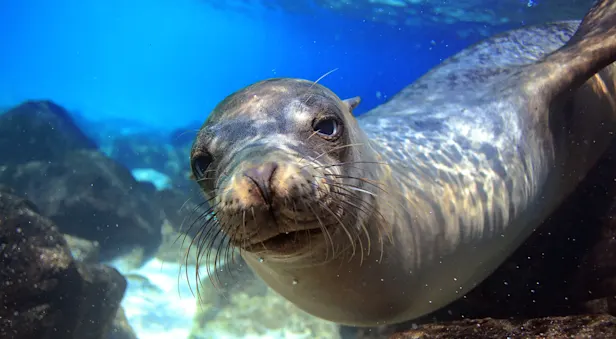Know Before You Go
Galapagos Sea Lion Facts | Galapagos Wildlife Guide
The most common native mammal you will see during your Galapagos expedition is the Galapagos sea lion, a subspecies of the Californian sea lion, which inhabits most islands. There are an estimated 50,000 individuals in the Galapagos Islands.
Physical Characteristics
Bulls weigh about 550 pounds on average but can reach up to 900 pounds
Females weigh about 200 pounds on average but can reach up to 250 pounds
They have thick necks, and the males are also thick through the shoulders and chest
Females are longer and slimmer than males
Range and Habitat
Galapagos sea lions are found in two places: the Galapagos Islands and on Isla de la Plata, which is about 25 miles off the coast of Ecuador.
Behavior and Communication
Territorial bulls can exhibit aggressive behavior. In the past, they have chased swimmers out of the water. They have also been known to bite if harassed, so do not approach them too closely. On the other hand, females and pups are amiable and playful, and they will often have fun swimming with snorkelers.
Dominant males patrol and guard particularly attractive beaches, territories that may contain up to 30 females. The dominant male will have mating access to these females but only for as long as he is able to keep other males at bay. Defending a territory is very demanding work, and males may go for days without getting much food or sleep. After several weeks putting up this front, the harem master may become weary and susceptible to defeat, causing him to lose his position to a new, well-rested male.
Galapagos sea lions are very playful animals, and the sound they make is similar to a dog’s bark.
Feeding Habits
Sea lions eat a variety of fish that can be found within a few miles of shore. They seldom go farther out than that because then they risk being eaten by sharks and whales.
Breeding and Reproduction
Females reach sexual maturity at age 5; males are capable of mating then, too, but usually do not do so until they are older. The dominant male has mating access to females but only for as long as he is able to keep other males at bay.
Females become sexually receptive once a year. The gestation period lasts nine months and the (usually) solitary pup is born around the beginning of the dry season. After nursing her pup for one week, the mother will return to the water to feed. Thereafter, she will continue nursing, after her fishing trips, until the pup is 5 or 6 months old, when it learns to fish on its own. Even then, the pup will continue to supplement its diet with its mother’s milk; some females may even nurse two pups, born in subsequent years, at the same time.
Conservation
Galapagos sea lions are heavily protected, even though there are about 50,000 of them. El Niño is their biggest threat, as it can result in many of them being killed due to lack of food, the females may not want to mate and many will abandon their offspring.
Snorkel with Sea Lions on These Galapagos Trips

Galapagos Discovery: The Nat Hab Experience
Small-group adventures aboard your choice of private yachts, led by our outstanding naturalist guides and photography pros. Snorkel and swim with sea lions, sea turtles and penguins on this incomparable nature odyssey.
























